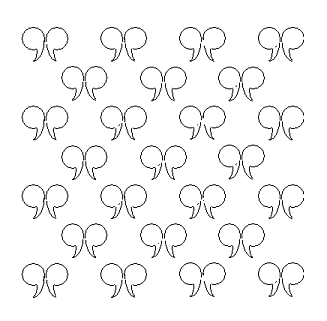Non-primitive Bravais Lattices
Now let's consider the 7 non-primitive lattices. These are ones with more than one lattice point per unit cell. Remember: unit translations along the axes generate the entire crystal from the unit cell, and lattices contain points that are translationally equivalent. There's nothing we've discussed so far that rules out the possibility of having lattice points that are related by non-unit translations. We can always define a primitive cell for the lattice, but often, other symmetry considerations support the choice of non-primitive unit cells.
Here's an example of such a case.

Here are two alternative unit cell choices for this lattice. Cell A contains one set of mirror-related objects and thus one lattice point, but the cell isn't oriented with the mirror along one of the axes and isn't as useful in the mathematical description of the array as it might be. Cell B on the other hand, although it's twice as big with two lattice points, is easier to deal with because of the orientation of the axes and the mirror plane. The additional lattice point making this a non-primitive cell is "centered" in the cell and located at 1/2,1/2.

When this idea is extended to three-dimensional arrays, you can come up with an additional 7 non-primitive lattices that have additional lattice points "centered" in particular positions. If the extra point is in the center of the unit cell face opposite the c axis, it's considered a "C-centered" lattice. You can also have "A-centered" and "B- centered" cell. If the point is in the center of all three faces, the label is "F-centered", and if the point is in the center of the cell (at 1/2,1/2,1/2), it's an "I-centered" lattice.
Here are the resulting 7 non-primitive Bravais lattices.
First is a C-centered monoclinic cell.

Then three C-, I-, and F-centered orthorhombic cells.



And one I-centered tetragonal cell.

And two I- and F-centered cubic cells.


OK. So now you've been exposed to the 14 Bravais lattices.
 back to index
back to index
 next topic
next topic
 previous topic
previous topic
copyright © Ron Stenkamp stenkamp@u.washington.edu Most recent update 1/7/97